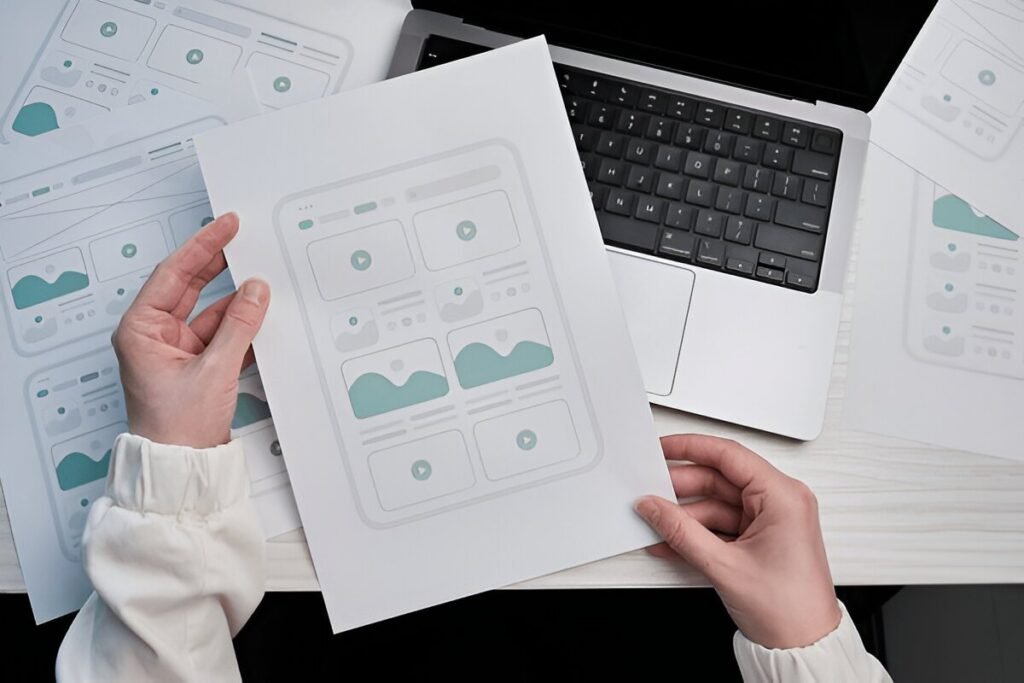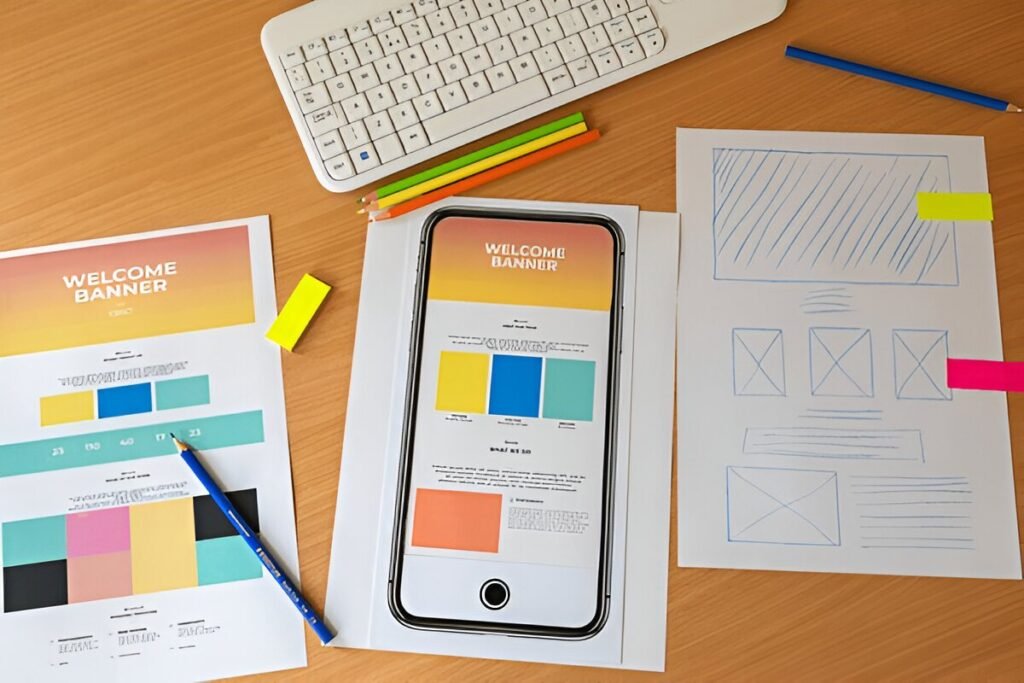
Want to expand your internet business? Begin by designing an effective landing page templates that converts interested visitors into clients.
Every online company need a well-optimized landing page templates where traffic flows in from many sources and pushes customers to convert.
The average eCommerce business landing page templates conversion rate is about 12.9%, so you can see how critical it is for your company to have well optimized landing page templates.
If you disregard the architecture of your landing page templates, or worse, do not construct one at all, your purchases will fall through the gaps.
This blog will cover all of the principles and approaches, along with examples, needed to create spectacular landing page templates that increase conversions.
What is a landing page templates?
A landing page templates is a specialized website that persuades your clients to do a certain action, such as buying a product, signing up for a service, or doing anything else. To be most successful, your LP should be clear, targeted, and provide useful information that encourages conversions.
A landing page templates is often the initial point of contact for visitors who arrive via an advertisement, social media post, or search result. Its major goal is to convert visitors into leads or customers by presenting a customized message that speaks to their requirements.
For example, check at our well optimized WordPress hosting landing page templates. It clearly expresses what we provide, backed up with social proof, price data, and other critical elements—all presented in a short, appealing way to increase conversions.
Why do you need a landing page templates?

Well-designed landing page templates have one purpose: to compel visitors to perform a certain action, such as signing up, purchasing a product, or requesting a demo.
A high-converting landing page templates is more than simply visually appealing; it’s also carefully structured to direct visitors to a certain action.
Here are a few reasons why your organization need specialized landing page templates.
1. Create a lasting first impression.
A landing page template may make or break your brand’s first impression. The goal of a well-designed landing page template is to offer highly relevant messages to your clients, converting them from visitors to paying customers.
The only way to do this is to undertake extensive consumer research and divide your customers into several buyer personas to guarantee that the proper message reaches the right audience, resulting in improved conversions.
Take Airbnb as an example. Airbnb’s straightforward and inviting home page has eye-catching pictures, engaging language, and a clear “Airbnb Setup” button that directs customers to establish an account.
Airbnb’s focus on user experience resulted in a large sign-up increase. By creating logical and visually appealing landing page templates, you establish the groundwork for a powerful, positive first impression.
2. Improve Customer Confidence with Trust
Trust is ultimately what motivates clients to take the next step—a leap of faith, if you will—and landing page templates provide an excellent chance to develop it. When prospective consumers visit your website, trust features such as customer reviews, security badges, and genuine testimonials may reassure them.
Bizzabo is an excellent example of this, with its landing page templates including user testimonials and accolades to boost legitimacy.
3. Increase conversion rate.
landing page templates are designed to increase conversions, and each effective one has a clear goal and an efficient flow. So, if your landing page templates’s goal is to gather leads, it should feature a clear and easy call to action with few stages to decrease friction.
A case study with Moz shown how streamlining forms resulted in a 35% boost in conversions. Moz increased lead conversion by minimizing the amount of form fields and introducing clear call-to-action buttons.
Different types of high-converting landing page templates

Not all landing page templates are made equal, and the optimum structure is frequently determined by your target demographic and messaging. Each variety has a distinct strength; let’s look at the most effective.
Minimalist landing page templates with Text Only
Simplicity may be powerful. Text-only landing page templates eliminate distractions, allowing the material to do all the heavy work. These pages are simple, frequently focused on a single, powerful message that connects with the intended audience. This style of page often includes a few graphics to avoid making the page seem excessively text-heavy or uninteresting.
Here’s an example of one of our landing page templates, which features just one video in the hero fold but focuses on text that highlights the advantages our product provides to our clients.
Long or Short Form landing page templates?
Should you choose a lengthy or short copy? The solution is in your audience and product. A lengthier copy may give the required information for items with a high level of complexity, such as electronics. On the other side, for impulsive purchases, a brief text might be more successful since it immediately captures attention.
Companies such as Apple thrive at this, use brief, passionate language and a clear call to action. Whether you use lengthy or short text, the goal is to match the amount of information to your audience’s decision-making requirements.
Impactful landing page templates with Video Content
Video landing page templates mix narrative and persuasion. More organizations are using video landing page templates to increase engagement and conversion. If a picture is worth a thousand words, a landing page templates video is worth thousands more.
A strong video can convey complicated concepts quickly, connect with the audience, and improve conversions by up to 86%.
Here’s how Scribe Media utilizes their video landing page templates to educate customers about their self-publishing book services. Of course, it is not their major call to action here, as they have a ‘Schedule a Consult’ button just below it.
How to Create Your Own High-Converting landing page templates
A landing page template that converts successfully requires a combination of research, planning, and execution. When you understand your audience and create a page with their requirements in mind, you’re significantly more likely to get the outcomes you want.
Let’s take a look at how to create a landing page template that actually connects with and converts your audience.
Step 1: Conduct Market Research
Market research is the cornerstone of any successful landing page templates. The better you understand your clients’ pain problems and what they are searching for, the closer you will be to designing a page that speaks to them.
Peloton spent research to better understand its target demographic, which is health-conscious and seeks ease. This information enabled them to concentrate their landing page templates on the advantages of working out at home, including testimonials from people who altered their fitness habits.
Here’s how to do market research for your landing page templates:
Study Competitor Pages
Analyze landing page templates from rivals and top businesses in your field. Look for patterns in layout, text, and calls-to-action (CTAs), highlighting factors that seem to increase engagement. This might bring inspiration and insight into what is currently succeeding in your area.
Define your target audience.
Conduct research to better understand your target audience’s preferences, pain areas, and needs. Understanding who they are and what they need allows you to adapt your language and design, ensuring that your landing page templates resonate and encourages action.
Test and optimize continuously.
Plan to do continuing A/B testing to discover the most successful layout, headline, and CTA. Experiment with different aspects, such as form length and button color, using data from early user interactions.
Connect with visitors by understanding their mindset.
Visitors to your website are often looking for a solution or a fast response. Understanding their perspective allows you to speak their language and gently encourage them toward conversion.
Netflix’s landing page templates take into account the visitor’s mindset: consumers seeking for economical, no-commitment entertainment. Netflix appeals to a flexible attitude by providing a “Free Trial” and “Cancel Anytime” statement up front.
Understanding Keyword Intent

Understanding keyword purpose is critical when it comes to creating content that is effective. Essentially, keyword intent is all about determining why someone is looking for something—what they really want to discover.
When you understand precisely why someone would check anything up online, you’ve done well in terms of good landing page templates.
There are three major forms of keyword intent:
- Informational Intent: These users desire knowledge. If a person looks for “which is the best WordPress hosting,” it suggests that they are not yet ready to purchase and are seeking guidance. If your landing page template targets informative keywords, it should offer quality content that educates and builds trust.
- Navigational Intent: These individuals know where they want to go but need assistance locating it. A search for “Nike running shoes official store” indicates that the user wants to find a certain brand or resource. A well-optimized landing page template guarantees that customers can easily locate what they’re looking for.
- Converting Intent: These are the money makers. Keywords like “buy running shoes online” suggest that the consumer is prepared to make a purchase. To convert these visitors, your landing page templates must be optimized with clear calls to action, a simple checkout procedure, and appealing language.
Step 2: Design Your landing page templates
A visually appealing design brings your landing page templates to life! A powerful design not only looks fantastic, but it also easily directs visitors to conversion.
Let’s take a look at what design components contribute to a good landing page template.
Well-crafted Hero Section
The hero section is the first item visitors will view and sets the tone for the whole page. This part should quickly capture their attention, demonstrate their goods, and urge them to learn more.
Consider Jasper as an example. Their landing page templates hero section is clean and straightforward, and it immediately communicates the product’s objective.
With a clear headline and a visible “Try Jasper Free” button, Jasper keeps visitors focused on the action they want to take.
Highlight your unique selling proposition.
Make sure your unique selling proposition (USP) stands out from the competitors.
By explicitly outlining your unique selling point, you show visitors why they should select you above anybody else. When your USP stands out, it reinforces your message and improves the efficacy of your page.
Slack’s main page stresses “Where work happens,” emphasizing the platform’s primary value of simple team communication. This USP is more than simply catchy; it speaks directly to Slack’s target audience of teams wishing to improve communication.
Simplify your call to action.
Your call to action (CTA) should be the most direct and engaging aspect of your website. Whether it’s “Get Started,” “Join Now,” or “Download Free Guide,” make it obvious what the next step is.
Amazon nails this on their Prime sign-up page with a single call to action: “Try Prime Free.” It’s straightforward, obvious, and enticing, leaving no ambiguity about what the visitor should do. By keeping your CTAs short and apparent, you can eliminate hesitancy and increase conversions.
Use social proof.
Social proof fosters confidence by convincing visitors that others have benefitted from your goods. This might include testimonials, reviews, or success stories. Casper, a mattress manufacturer, employs social proof on its landing page templates, including “5-star” user evaluations and testimonials from satisfied customers.
This technique promotes the impression that Casper’s mattresses are popular and well reviewed. When visitors see others praising your product, they are more inclined to participate and convert.
Track key metrics to improve landing page templates performance.

landing page templates are the engines that power internet conversions. But how can you tell whether yours is running on all cylinders?
Here’s how you monitor, evaluate, and optimize the metrics that matter.
1. Keep an eye on your conversion rates.
This is the North Star for landing page templates performance. The conversion rate is the proportion of visitors who do a desired action, such as joining up, downloading, or paying. A high conversion rate indicates that your message is effective with visitors, while a low rate indicates that you should improve your offer or call-to-action (CTA).
How to track: Use Google Analytics or landing page templates software.
Optimize: Use A/B testing for CTA buttons, headline changes, and even color changes to see what drives conversions.
2. Low bounce rate is key to success.
The bounce rate is the proportion of visitors that arrived at your website but did not continue. If this rate is excessively high, there may be a problem with your landing page templates. Probably the information is irrelevant to the ad they clicked, or the loading time was too long.
- How to track: Once again, Google Analytics will show you the bounce rate of your landing page templates. Optimize ad messaging to match landing page templates content for faster load times and increased mobile visibility to retain visitors longer.
- Optimize: To keep visitors engaged, optimize the page by matching ad wording to landing page templates content, increasing load speed, and ensuring it appears nice on mobile devices.
3. Scroll Depth: Assessing Interest Levels
Scroll depth indicates how far visitors go down the page, which helps you determine which portions pique their attention. This measure is particularly useful for lengthier landing page templates that need visitors to browse through many parts before clicking the CTA. Track scroll depth using tools like Hotjar or Crazy Egg, and adjust as appropriate.
4. Page load speed: the first barrier to conversion
A slow-loading website may reduce performance, resulting in high bounce rates and lost conversions. A one-second delay in loading may have a 7% effect on conversion rates.
Every second matters, and studies indicate that even a one-second delay may result in substantial decreases in conversion rates.
- How to track: Use Google PageSpeed Insights or GTmetrix.
- Optimize: To speed the delivery of your landing page templates, compress pictures, use browser caching, and consider a content delivery network (CDN).
also learn How to Build a Coaching Sales Funnel that Converts and Grows Your Business
Conclusion
There you have it. Hopefully, this article will help you create high-converting landing page templates. Before you begin developing your own landing page templates, review the examples of some of the top high-converting landing page templates featured in this blog.
Consider A/B testing to improve the conversion rate of your landing page templates. Continuous testing will help you determine what works and what needs to be altered.
If you believe we missed something, please let us know in the comments section below.